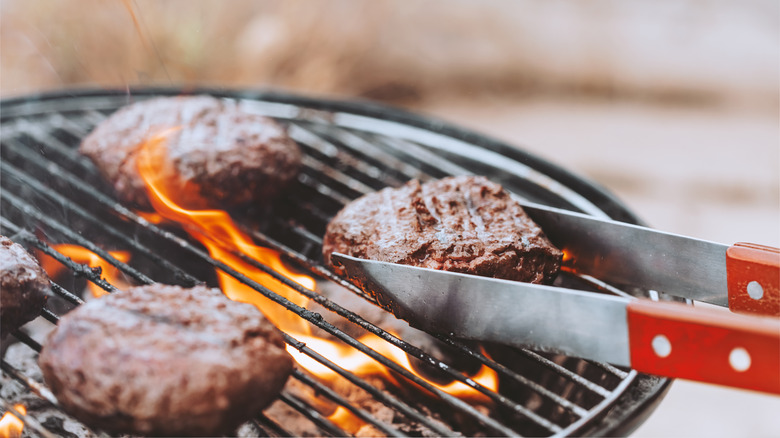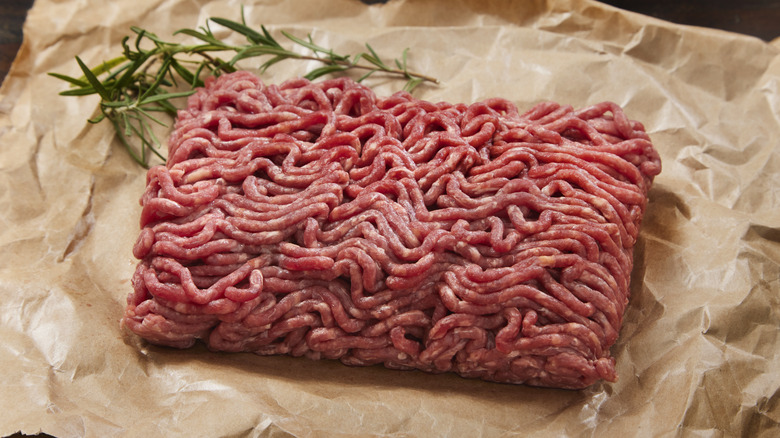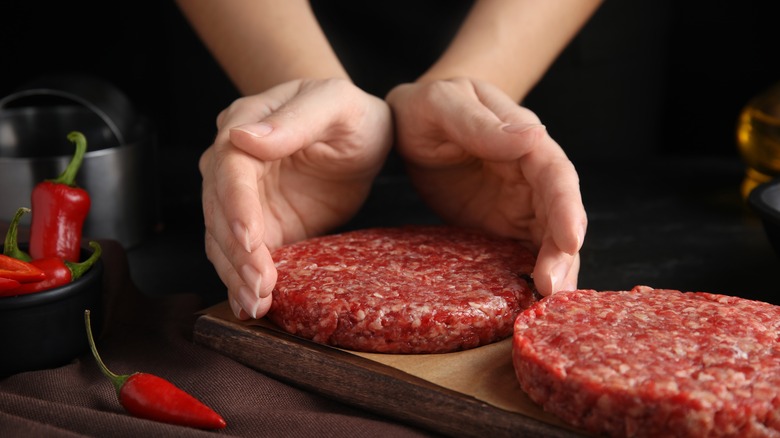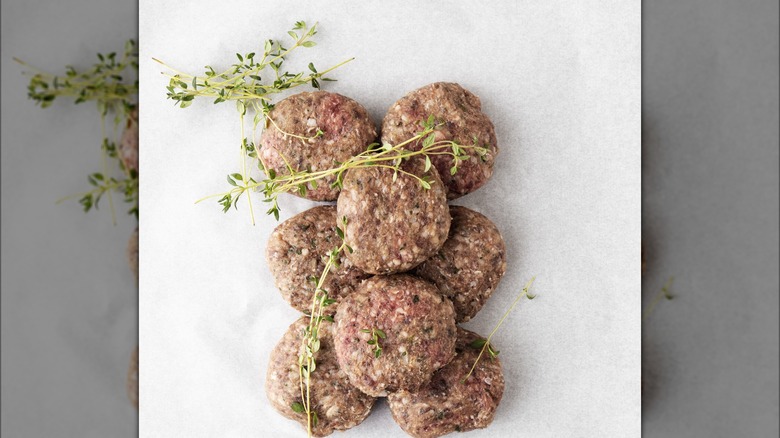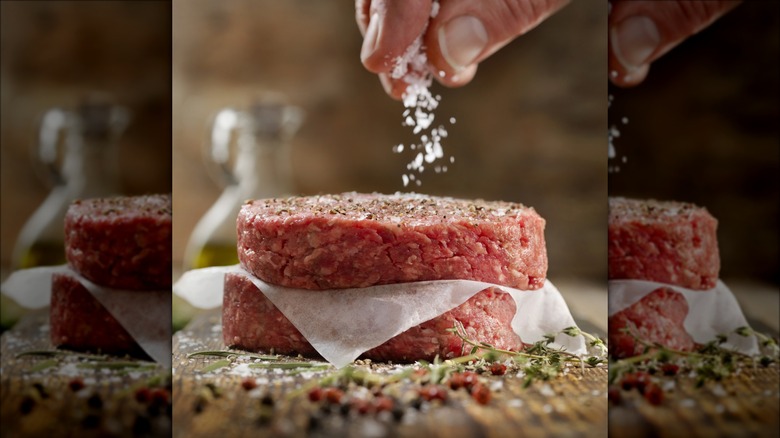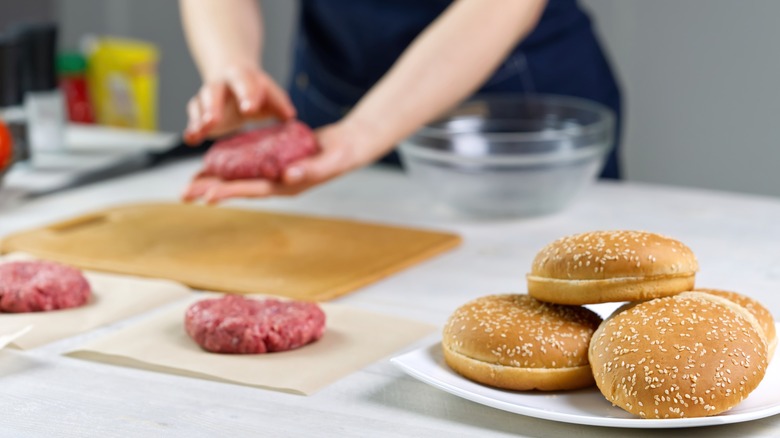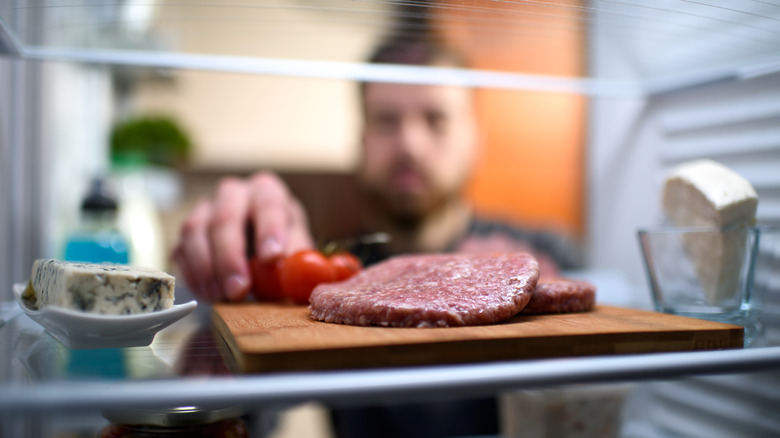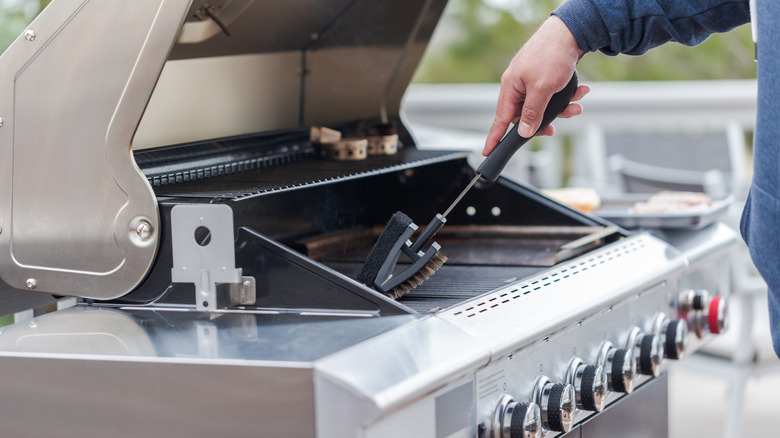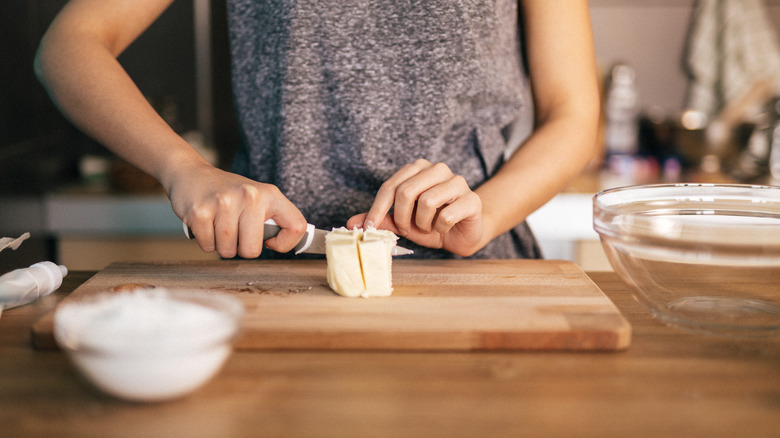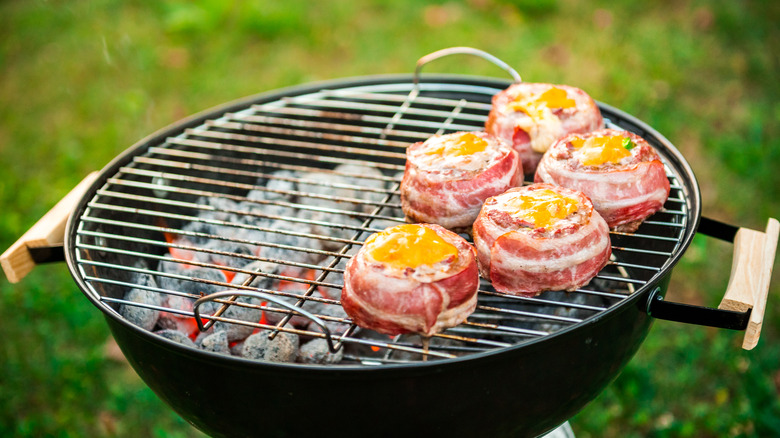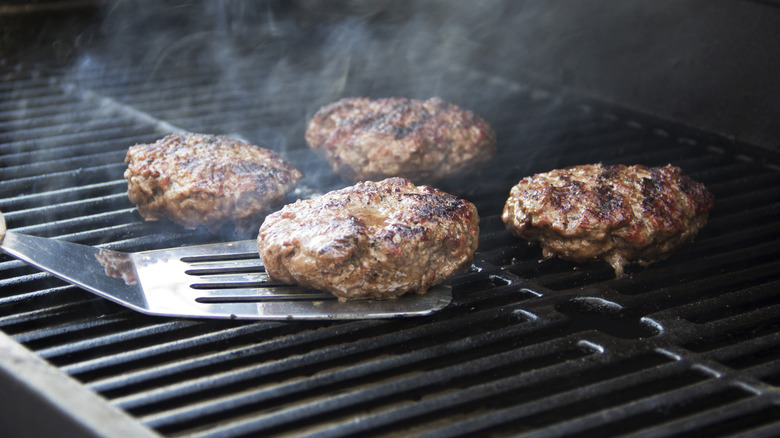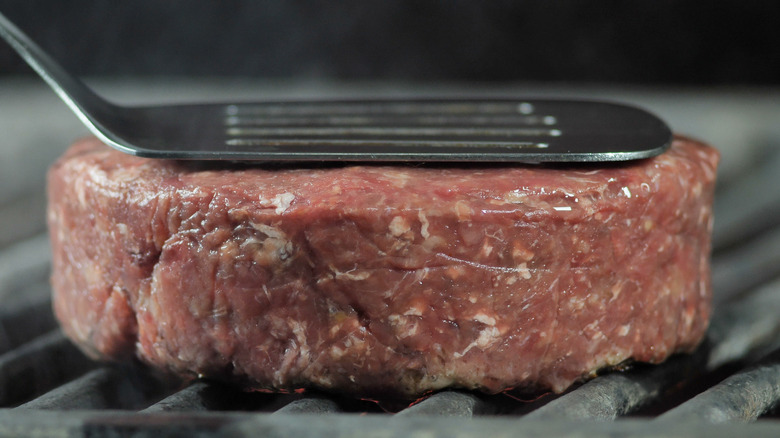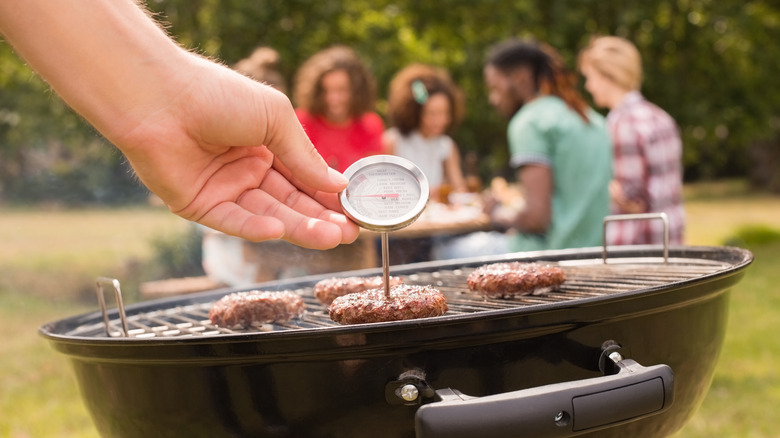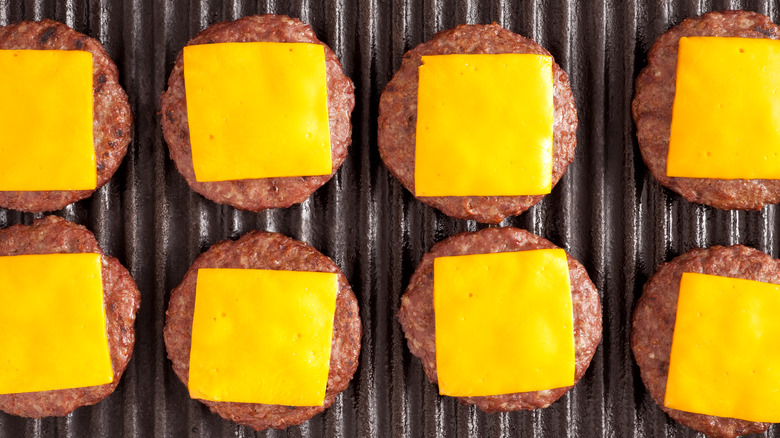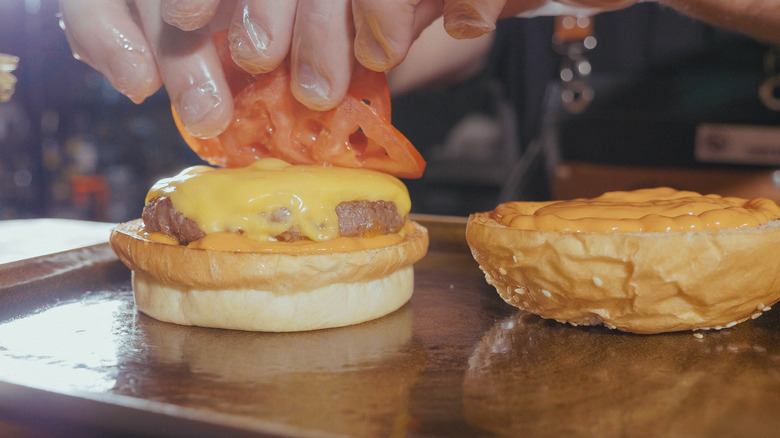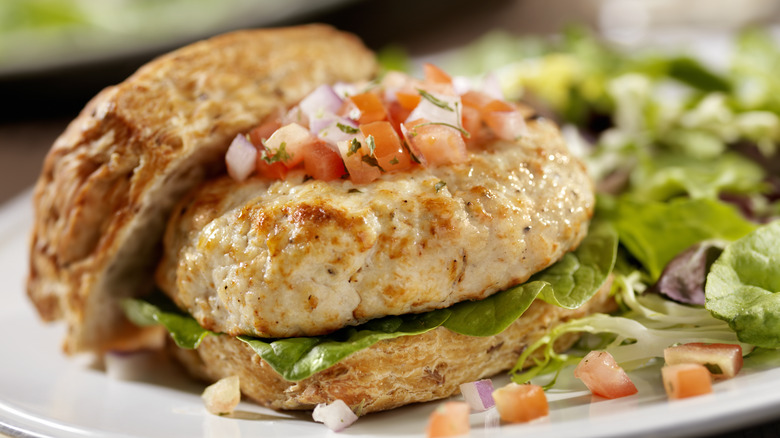15 Essential Tips For Grilling Perfect Burgers
Whether you're gearing up for a summer barbecue or just looking to make a tasty meal on the grill to share with your family, you want your burgers to turn out tasting amazing. We've all had really great burgers, and we've all been let down by a dry, undercooked, overly charred burger that just didn't taste right. In theory, burgers shouldn't be too difficult to cook, right? You just have to mix some ground beef and a few seasonings and cook them over a hot grill.
While this may sound pretty basic, the reality is that there are a lot of different things that come into play when grilling perfect burgers. Following a few key tips throughout the burger-making process — starting with choosing the right type of meat through serving your burgers from the grill — will help you craft a juicy and mouth-watering burger that you and your guests will devour. Many of these tips likely represent a very small change to what you may be doing now when preparing burgers. But the results they yield won't be small; they'll have a massive impact on how your burgers turn out.
Start with an the ideal meat to fat ratio
The perfect burger starts with the right type of meat. Traditionally, hamburgers are made using ground beef, so we'll focus on that. You probably already know you can find ground beef with different meat-to-fat ratios. For example, ground chuck has about 80% lean meat and 20% fat, ground round is around 85 to 90% lean meat and 10 to 15% fat, and ground sirloin has about 90 percent lean meat and 10% fat. Fattier cuts are the best choice when you're looking to make the juiciest burgers possible.
Ground chuck with about 80% lean meat and 20% fat is ideal for burgers. This cut, which comes from the shoulder area of a cow, will offer the best flavor. The more lean the ground beef, the less juicy the burgers will be. If you want to save a few calories, you could try ground round with about a 15% fat content, but you should probably stay away from anything leaner than that. When you're really trying to watch fat and calories, burgers may not be the best choice.
Keep food safety in mind when handling the raw beef
Raw beef, like other types of raw meat, can hold bacteria. Keep food safety in mind when preparing your burgers to avoid inadvertently serving up a side of food poisoning with your meal. To start, make sure that the meat you're using is fresh by checking expiration dates and using or freezing ground beef within two days of purchasing it.
According to the United States Department of Agriculture, perishable food should not be left out of the refrigerator for more than two hours. Otherwise, you're risking letting the temperature fall into the Danger Zone (temperature range between 40 and 140 degrees Fahrenheit) where bacteria can multiply very rapidly. For this reason, make sure you promptly refrigerate your ground beef after purchasing it and avoid leaving it out for too long when preparing the burgers. Frozen ground beef should be thawed in the refrigerator overnight or in cold water to prevent its temperature from reaching the Danger Zone.
You must also be very careful when handling raw meat. The Food and Drug Administration shares that you should always wash your hands thoroughly before and after touching the meat. Avoid touching other items or surfaces — such as the refrigerator handle or jars of seasoning — if you have not yet washed your hands. After preparing your burger patties, be sure to clean the counters and wash any bowls or tools that came into contact with the raw meat.
Don't overseason the meat
Seasoning your burgers doesn't have to be complicated. In many cases, all they'll need is a little bit of salt and pepper, but you can also add other seasonings to complement the taste of the meat, cheese, or other toppings you'll be pairing with the finished product. A few ideas to try include garlic powder, onion powder, and paprika. If you want to give your burgers more of a kick, you could even try some chili powder, cayenne pepper, or red pepper flakes.
Regardless of whether you stick with just a little bit of salt or want to take things up a few notches with cayenne pepper, you want to be careful not to overseason the meat. Of course, everyone's preferences will vary, so you might need to experiment with different ratios of seasonings to meat to find the ideal combination for your taste buds. However, as a general rule, aim to use about 3 teaspoons of seasonings total for each pound of ground beef.
Don't salt the burgers until you're ready to grill them
While we're on the topic of seasoning your burgers, there is one more very important tip specifically related to salt: Don't add salt to the burger mix ahead of time. Instead, only salt the outside of the patties just before you're ready to toss them on the grill.
Salt dissolves proteins. This means that if you add it to your hamburger meat ahead of time, it will start to break down the meat. The longer you wait before cooking the patties, the more of the protein that the salt will break down. As the meat sits and the salt breaks down the protein, the patties will become more and more compact. When cooked, they'll end up with a much firmer and rubbery texture. Unless this is what you love about a burger (highly unlikely), stick with just adding the salt to the patties right before you put them on the grill to give your burgers the ideal texture.
Know how to properly form the patties
There are several things to keep in mind when forming your burger patties. First, you want to start with cold — not room-temperature ground beef. Otherwise, the fat in the meat is going to start to melt when you're trying to form the burgers with your warmer hands. If this happens, the result will be a drier burger, the opposite of the nice and juicy one you're aiming for.
One common mistake that people make when preparing their patties is overworking the meat. You don't want to handle the meat more than is absolutely necessary to avoid drying it out and causing the burger to crumble. Once you've added the ground beef and any other ingredients you want to use (reserving the salt for later), try to spend a maximum of 40 seconds or so working all the ingredients together and forming them into patties. You can check to see if everything is well integrated by taking a small scoop of the burger mix and squishing it between the palms of your hands. It should be ready to go if some of it sticks against one palm.
Keep the burger patties cold until grilling
When preparing hamburgers, one of the most important things to avoid is letting the fat start to melt before you toss them on the grill. If this happens, the burgers are going to turn out dry; that fat is what makes them so juicy and delicious. For this reason, it is important to put your formed patties back in the fridge after they're prepared. Keeping them cold will prevent the fat from melting and ensure that the finished product is exactly what you've been craving.
This piece of advice may go against what you've been taught related to cooking meat. Often, it is recommended to let roasts and other cuts of meat come to room temperature before cooking. However, with burgers, don't follow this advice. Unless you plan to throw the burgers on the grill immediately after they're formed, just put them on a plate, cover them, and return them to the fridge.
Make sure your grill is clean before you fire it up
If you're not cleaning your grill before using it to grill burgers, it is time to change your habits. A dirty grill can cause several problems that are going to impact the taste and safety of the burgers you're preparing. The traces of old food stuck on the grill could be holding bacteria and viruses. When you cook your burgers right over these old pieces of food, the viruses and bacteria could transfer to them and make you or others sick. With repeated use, grills can be covered with carcinogenic residue. Failing to remove as much of this residue as possible means that it can be transferred to the new items you're cooking, putting everyone's health at risk.
Beyond the health and safety reasons to clean a grill, your burgers just aren't going to taste as good when cooked on a dirty grill. Residues of old meats and sauces will affect the flavor of your burgers negatively. Moreover, failing to clean your grill can lead to more maintenance issues and a shorter lifespan. You'll likely find yourself needing to purchase more replacement parts or paying for more repairs than you would if you followed the recommended cleaning procedures.
Use a little butter for an extra juicy burger
If you're all about those juicy burgers, then we have one more tip that you're certain to appreciate. Bring out your butter the next time you're cooking burgers on the grill. This cooking technique comes from Wisconsin and is certain to help you craft one of the juiciest burgers you've ever had the pleasure of enjoying. What's better? Making a butter burger won't add hardly any more prep time for you.
There are two different approaches you can take. The first is to simply place a little pat of butter on the top of your burger once you toss it on the grill. As the burger cooks, the butter will melt and seep into the meat. The other option is to add some butter to your burger mix. If you want to try this approach, you'll want to freeze some butter and grate it before mixing it in. This way, the butter won't start to melt until the burgers are on the hot grill.
Set the grill up to have a direct heat side and an indirect heat side
Before you put your burgers on the grill, you'll want to set it up so that there is a direct heat side (directly over the coals or flames) and an indirect heat side (a little away from the direct heat of the flames or coals). With this setup, you'll be able to ensure that your burgers cook properly, the cheese melts perfectly, the buns get nicely toasted, and everyone's burger is cooked to their desired doneness level without turning out overly charred.
For the most part, you'll want to cook the burgers over direct heat. Direct heat cooks food relatively quickly, giving it a charred outer edge. This is perfect for burgers. Once your burgers are nearly cooked to the preferred doneness, slide them over to the indirect side to add cheese. This will create an environment that is warm enough to melt the cheese without charring it or overcooking the burger. The indirect heat side of the grill is also the perfect spot to place the cut hamburger buns to toast them up a bit before serving.
The indirect heat side is also helpful when cooking burgers to well-done or medium-well. While these doneness levels will require a longer cooking time, the patty will end up too charred if left over the direct heat. Let them continue cooking once you remove the other burgers for a few additional minutes.
Flip the patties only one time
Flipping patties back and forth is another mistake to avoid. It can be difficult to just let the patty sit there. You may be getting impatient and want to speed things along or worried that the bottom is going to get too charred, but it is important to be patient and trust the process. Burger patties should only be flipped one time. Expect it to take about five minutes (give or take) for the patty to be ready to flip. You can identify a patty that is ready to flip by looking at the top; there should be some juices coming out from the meat.
The problem with over-flipping the burgers is that more of the moisture content will be lost. Each time it is flipped, some of the fat will seep out, leaving the resulting burger much drier and less enjoyable than it could be. After one side of the burger has cooked for a few minutes (about 5, typically), you should be able to release it from the grill grates using the spatula without it sticking. Once this happens, it is ready to flip.
Avoid pressing down on the burgers as they cook
Another mistake that is going to leave you with a less exciting and delicious burger is pressing down on your patties as they cook on the grill. Some people think this helps to spread out the meat and allow the burgers to cook more quickly, while others might think that pressing down and releasing a bit of the fat to the flames helps to achieve a perfectly charred burger.
However, pressing down on the patties as you cook is not something you should do. When you press down, some fat is going to come out. Any time you lose fat from the patty, it makes the burger dry. Instead, just leave the burgers alone as they cook. Flip them about halfway through the process. But, other than that, keep your spatula away and let the heat of the grill take care of the cooking.
Use a meat thermometer to check for doneness
When you make burgers, it is important to ensure that they are fully cooked before eating them or serving them to your guests. Cutting into the burger isn't an appropriate way to check for doneness. First, you're going to lose some of the juice and will have at least one burger with a huge cut into it. The other real issue is that you can't safely gauge the internal temperature just by looking at the color of the meat.
Instead, you will want to use a meat thermometer to check for doneness and ensure that the entire burger is cooked enough to kill bacteria. Insert the thermometer into the thickest part of one of the burgers towards the center to get an accurate reading. While some people prefer their burgers to be rare (120 to 125 degrees Fahrenheit), medium-rare (130 to 135 degrees Fahrenheit), medium (140 to 145 degrees Fahrenheit), or medium-well (150 to 155 degrees Fahrenheit), keep in mind that the United States Department of Agriculture does recommend cooking burgers to a minimum internal temperature of 160 degrees Fahrenheit.
Choose the right time to add the cheese
There is a right time and a wrong time to add cheese to your burgers. Add it too early, and it will end up melting too much and slide off of the burger. Not only will this leave you or your guests with a cheeseburger that is lacking in the cheese department, but it could also leave a burnt-on mess on your grill. On the other hand, if you add the cheese too late, it isn't going to melt (or you're going to end up overcooking the burgers waiting for it to do so).
Since none of these are good options, you have to perfectly time when you add cheese to your burgers. Cheese won't take long to melt, so aim to add it to your burger about two minutes before the patties are cooked. Placing the burger over indirect heat and closing the grill lid will help the cheese melt. With the lid closed, there will be more hot air moving around inside of the grill and all around the cheese.
Be sure to serve the burgers promptly
Don't put your burgers on the grill until you have everything just about ready to go. Once they have finished cooking, you will want to serve them almost immediately. It is not really necessary to let the burgers rest, unlike many other types of meats that do benefit from sitting undisturbed for five or 10 minutes. Burgers are much smaller than larger cuts of meat, such as a roast. If you let them sit for too long, they'll become cold before you even serve them.
Instead, have the buns and all the toppings ready to go. In the few minutes, it takes everyone to assemble their burger how they like it, the meat will still be able to benefit from a few extra minutes to finish cooking and let all the flavors meld. But this way, the burgers will still be nice and hot when everyone enjoys their first bite.
Remember that you don't have to only use ground beef when making burgers
Most of this article has focused on tips related to making burgers with ground beef since that is the type of meat that is most commonly used for them. However, it is far from the only option you'll have when preparing burgers. Whether you're trying to cut red meat from your diet or are just looking to change things up from time to time, there are several beef alternatives. Some of the different options are even meatless, making them a good choice for anyone following a vegan or vegetarian diet.
Turkey burgers are one of the most popular alternatives that you've probably already heard about. But why stop there? You could also try pork burgers, bison burgers, tuna burgers, salmon burgers, black bean burgers, veggie burgers, lamb burgers, or chicken burgers. There are also plant-based options you'll find in the grocery store that are designed to mimic the taste and texture of beef.
